Design-Build Project Delivery System: Benefits and Key Differences
VerifiedAdded on 2023/06/13
|10
|2145
|59
Report
AI Summary
This report provides a comprehensive overview of the design-build project delivery system, contrasting it with the traditional design-bid-build approach. It explores the history, benefits, and challenges of design-build, particularly within the US water and wastewater sectors. The report covers key aspects such as legislation, procurement approaches, risk allocation, and the role of consultants. Furthermore, it delves into the practical aspects of project execution, including scheduling, value engineering, quality assurance, permitting, and dispute resolution. The report also touches on alternative project delivery methods like Design-Build-Operate and Alliance Contracting. The document emphasizes strategies for owners to achieve successful design-build projects. Desklib offers a platform to explore similar solved assignments and past papers for students.

Edited By Holly Shorney-Darby, PhD, PE
Black & Veatch Corporation
Design-Buildfor Wate
andWastewater P
Black & Veatch Corporation
Design-Buildfor Wate
andWastewater P
Paraphrase This Document
Need a fresh take? Get an instant paraphrase of this document with our AI Paraphraser
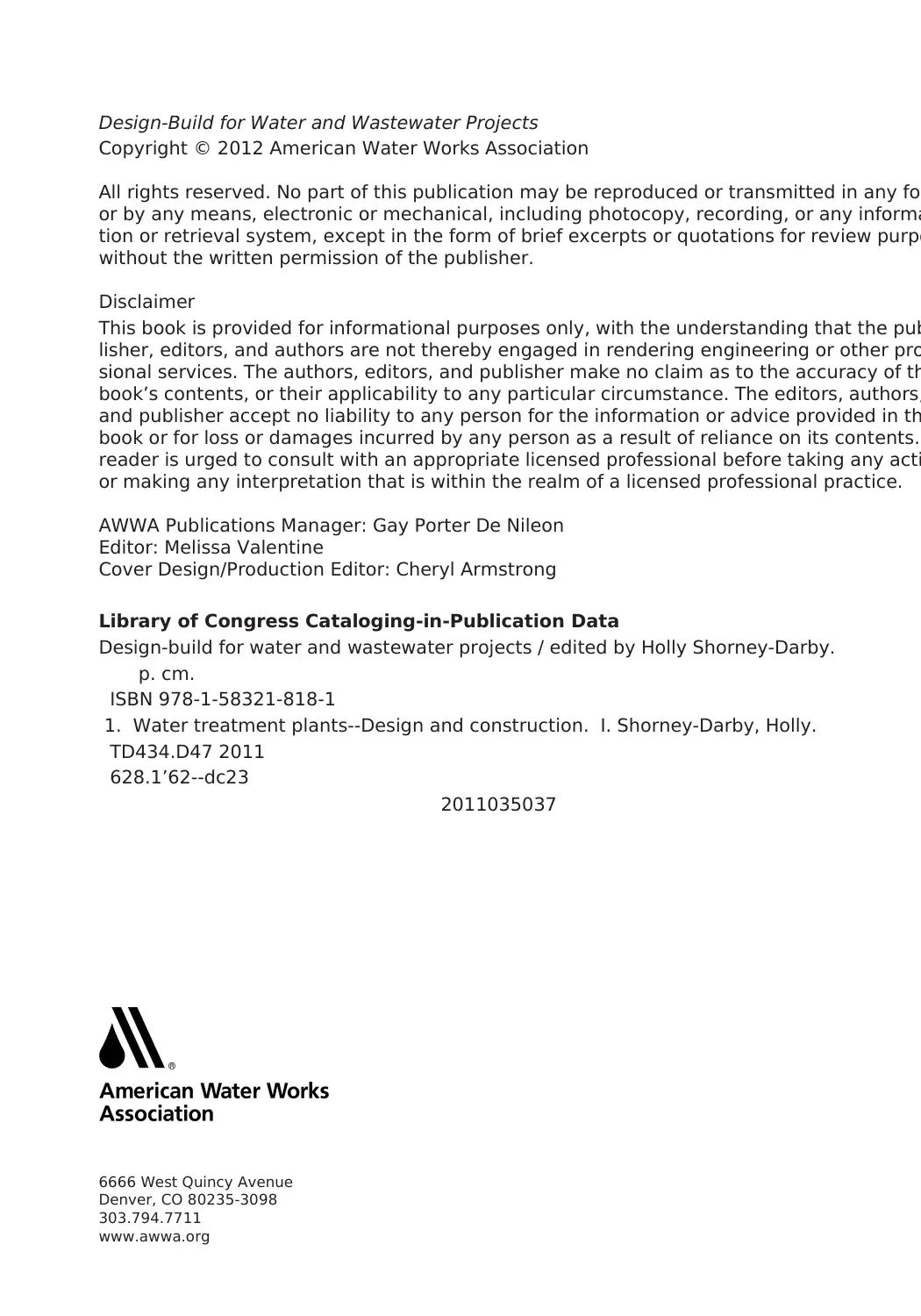
Design-Build for Water and Wastewater Projects
Copyright © 2012 American Water Works Association
All rights reserved. No part of this publication may be reproduced or transmitted in any for
or by any means, electronic or mechanical, including photocopy, recording, or any informa
tion or retrieval system, except in the form of brief excerpts or quotations for review purpo
without the written permission of the publisher.
Disclaimer
This book is provided for informational purposes only, with the understanding that the pub
lisher, editors, and authors are not thereby engaged in rendering engineering or other pro
sional services. The authors, editors, and publisher make no claim as to the accuracy of th
book’s contents, or their applicability to any particular circumstance. The editors, authors,
and publisher accept no liability to any person for the information or advice provided in th
book or for loss or damages incurred by any person as a result of reliance on its contents.
reader is urged to consult with an appropriate licensed professional before taking any acti
or making any interpretation that is within the realm of a licensed professional practice.
AWWA Publications Manager: Gay Porter De Nileon
Editor: Melissa Valentine
Cover Design/Production Editor: Cheryl Armstrong
Library of Congress Cataloging‑in‑Publication Data
Design-build for water and wastewater projects / edited by Holly Shorney-Darby.
p. cm.
ISBN 978-1-58321-818-1
1. Water treatment plants--Design and construction. I. Shorney-Darby, Holly.
TD434.D47 2011
628.1’62--dc23
2011035037
6666 West Quincy Avenue
Denver, CO 80235-3098
303.794.7711
www.awwa.org
Copyright © 2012 American Water Works Association
All rights reserved. No part of this publication may be reproduced or transmitted in any for
or by any means, electronic or mechanical, including photocopy, recording, or any informa
tion or retrieval system, except in the form of brief excerpts or quotations for review purpo
without the written permission of the publisher.
Disclaimer
This book is provided for informational purposes only, with the understanding that the pub
lisher, editors, and authors are not thereby engaged in rendering engineering or other pro
sional services. The authors, editors, and publisher make no claim as to the accuracy of th
book’s contents, or their applicability to any particular circumstance. The editors, authors,
and publisher accept no liability to any person for the information or advice provided in th
book or for loss or damages incurred by any person as a result of reliance on its contents.
reader is urged to consult with an appropriate licensed professional before taking any acti
or making any interpretation that is within the realm of a licensed professional practice.
AWWA Publications Manager: Gay Porter De Nileon
Editor: Melissa Valentine
Cover Design/Production Editor: Cheryl Armstrong
Library of Congress Cataloging‑in‑Publication Data
Design-build for water and wastewater projects / edited by Holly Shorney-Darby.
p. cm.
ISBN 978-1-58321-818-1
1. Water treatment plants--Design and construction. I. Shorney-Darby, Holly.
TD434.D47 2011
628.1’62--dc23
2011035037
6666 West Quincy Avenue
Denver, CO 80235-3098
303.794.7711
www.awwa.org
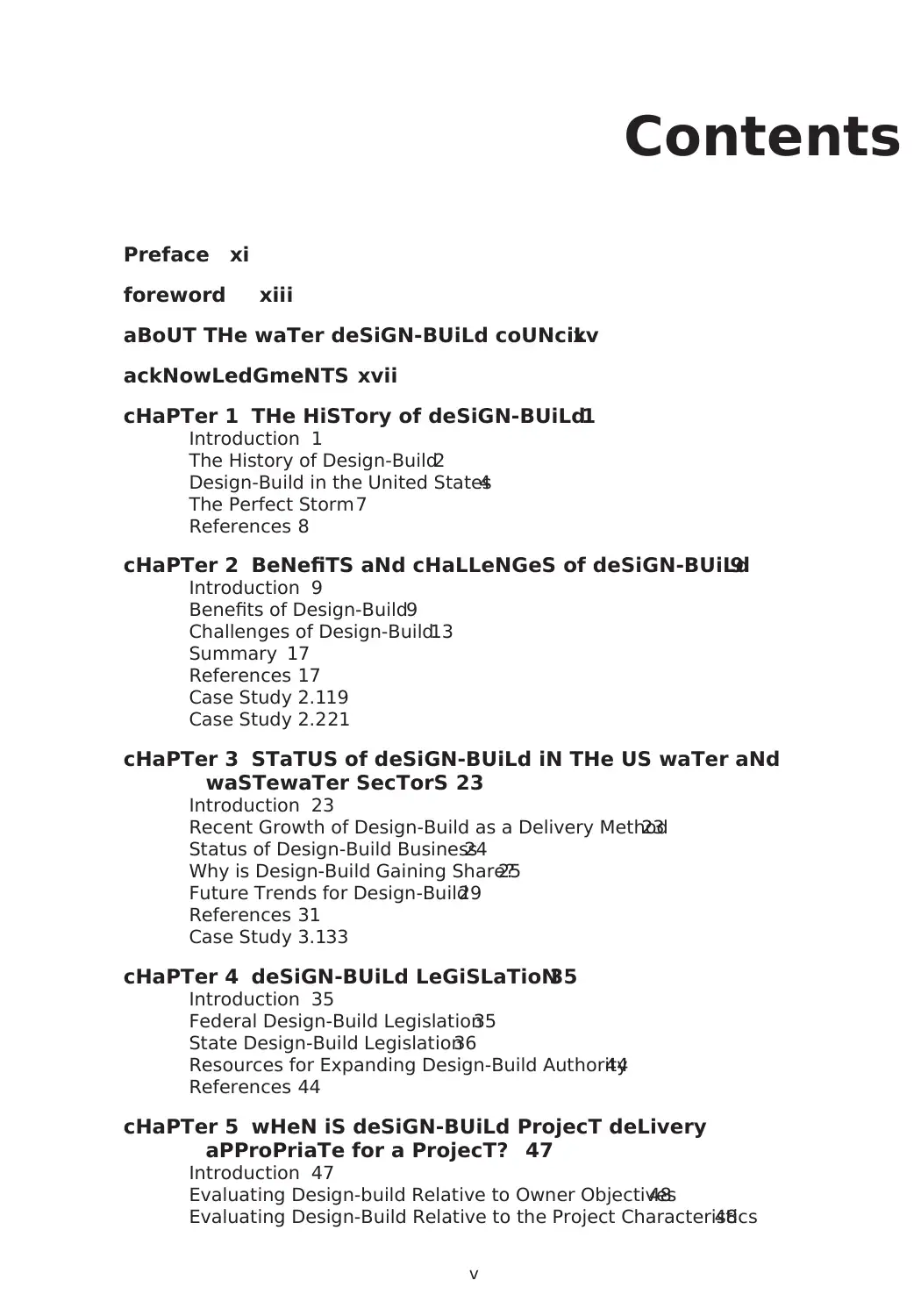
v
Contents
Preface xi
foreword xiii
aBoUT THe waTer deSiGN-BUiLd coUNciLxv
ackNowLedGmeNTS xvii
cHaPTer 1 THe HiSTory of deSiGN-BUiLd1
Introduction 1
The History of Design-Build2
Design-Build in the United States4
The Perfect Storm 7
References 8
cHaPTer 2 BeNefiTS aNd cHaLLeNGeS of deSiGN-BUiLd9
Introduction 9
Benefits of Design-Build9
Challenges of Design-Build13
Summary 17
References 17
Case Study 2.119
Case Study 2.2 21
cHaPTer 3 STaTUS of deSiGN-BUiLd iN THe US waTer aNd
waSTewaTer SecTorS 23
Introduction 23
Recent Growth of Design-Build as a Delivery Method23
Status of Design-Build Business24
Why is Design-Build Gaining Share?25
Future Trends for Design-Build29
References 31
Case Study 3.133
cHaPTer 4 deSiGN-BUiLd LeGiSLaTioN35
Introduction 35
Federal Design-Build Legislation35
State Design-Build Legislation36
Resources for Expanding Design-Build Authority44
References 44
cHaPTer 5 wHeN iS deSiGN-BUiLd ProjecT deLivery
aPProPriaTe for a ProjecT? 47
Introduction 47
Evaluating Design-build Relative to Owner Objectives48
Evaluating Design-Build Relative to the Project Characteristics48
Contents
Preface xi
foreword xiii
aBoUT THe waTer deSiGN-BUiLd coUNciLxv
ackNowLedGmeNTS xvii
cHaPTer 1 THe HiSTory of deSiGN-BUiLd1
Introduction 1
The History of Design-Build2
Design-Build in the United States4
The Perfect Storm 7
References 8
cHaPTer 2 BeNefiTS aNd cHaLLeNGeS of deSiGN-BUiLd9
Introduction 9
Benefits of Design-Build9
Challenges of Design-Build13
Summary 17
References 17
Case Study 2.119
Case Study 2.2 21
cHaPTer 3 STaTUS of deSiGN-BUiLd iN THe US waTer aNd
waSTewaTer SecTorS 23
Introduction 23
Recent Growth of Design-Build as a Delivery Method23
Status of Design-Build Business24
Why is Design-Build Gaining Share?25
Future Trends for Design-Build29
References 31
Case Study 3.133
cHaPTer 4 deSiGN-BUiLd LeGiSLaTioN35
Introduction 35
Federal Design-Build Legislation35
State Design-Build Legislation36
Resources for Expanding Design-Build Authority44
References 44
cHaPTer 5 wHeN iS deSiGN-BUiLd ProjecT deLivery
aPProPriaTe for a ProjecT? 47
Introduction 47
Evaluating Design-build Relative to Owner Objectives48
Evaluating Design-Build Relative to the Project Characteristics48
⊘ This is a preview!⊘
Do you want full access?
Subscribe today to unlock all pages.

Trusted by 1+ million students worldwide
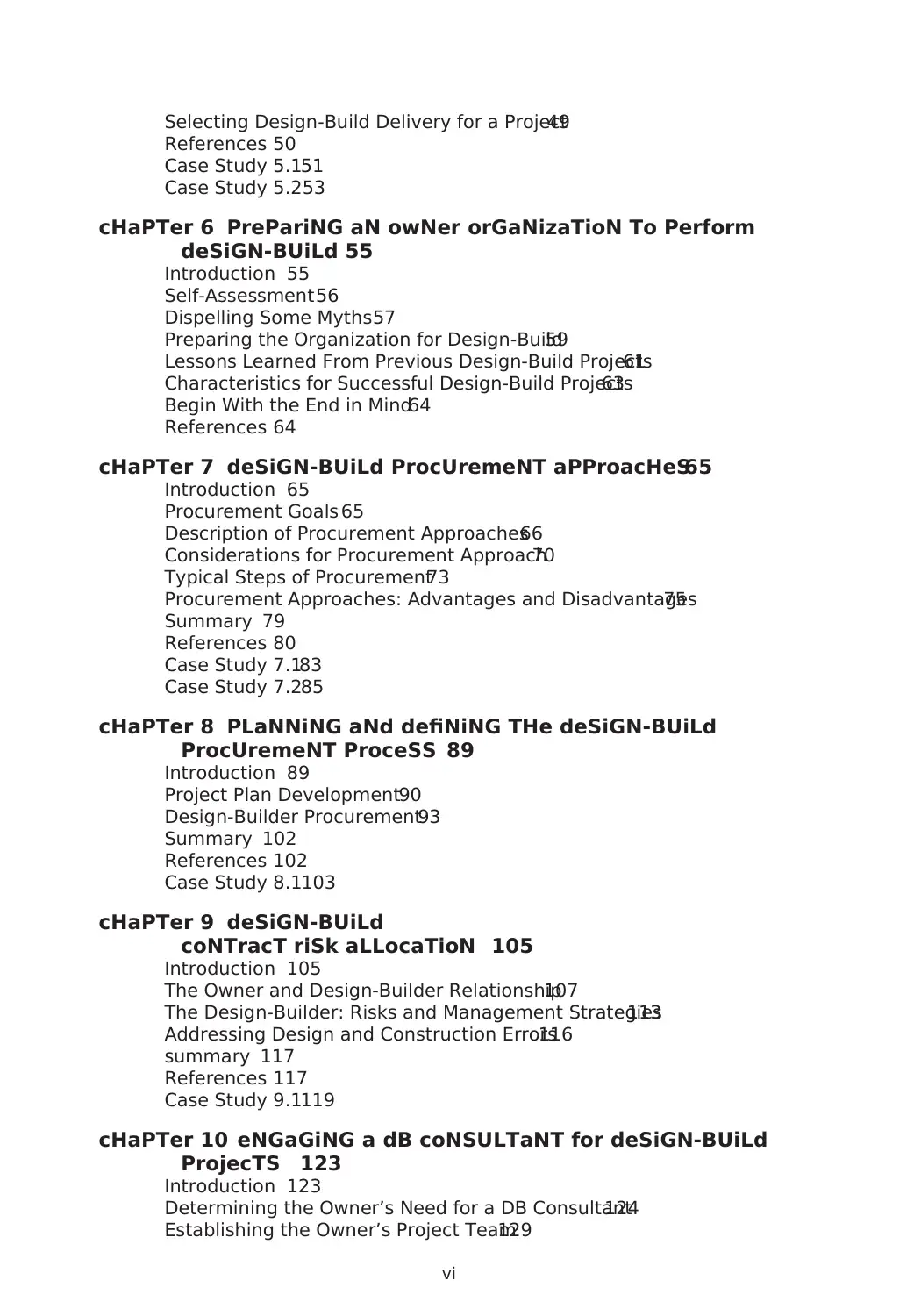
vi
Selecting Design-Build Delivery for a Project49
References 50
Case Study 5.151
Case Study 5.253
cHaPTer 6 PrePariNG aN owNer orGaNizaTioN To Perform
deSiGN-BUiLd 55
Introduction 55
Self-Assessment 56
Dispelling Some Myths 57
Preparing the Organization for Design-Build59
Lessons Learned From Previous Design-Build Projects61
Characteristics for Successful Design-Build Projects63
Begin With the End in Mind64
References 64
cHaPTer 7 deSiGN-BUiLd ProcUremeNT aPProacHeS65
Introduction 65
Procurement Goals 65
Description of Procurement Approaches66
Considerations for Procurement Approach70
Typical Steps of Procurement73
Procurement Approaches: Advantages and Disadvantages75
Summary 79
References 80
Case Study 7.183
Case Study 7.285
cHaPTer 8 PLaNNiNG aNd defiNiNG THe deSiGN-BUiLd
ProcUremeNT ProceSS 89
Introduction 89
Project Plan Development90
Design-Builder Procurement93
Summary 102
References 102
Case Study 8.1103
cHaPTer 9 deSiGN-BUiLd
coNTracT riSk aLLocaTioN 105
Introduction 105
The Owner and Design-Builder Relationship107
The Design-Builder: Risks and Management Strategies113
Addressing Design and Construction Errors116
summary 117
References 117
Case Study 9.1119
cHaPTer 10 eNGaGiNG a dB coNSULTaNT for deSiGN-BUiLd
ProjecTS 123
Introduction 123
Determining the Owner’s Need for a DB Consultant124
Establishing the Owner’s Project Team129
Selecting Design-Build Delivery for a Project49
References 50
Case Study 5.151
Case Study 5.253
cHaPTer 6 PrePariNG aN owNer orGaNizaTioN To Perform
deSiGN-BUiLd 55
Introduction 55
Self-Assessment 56
Dispelling Some Myths 57
Preparing the Organization for Design-Build59
Lessons Learned From Previous Design-Build Projects61
Characteristics for Successful Design-Build Projects63
Begin With the End in Mind64
References 64
cHaPTer 7 deSiGN-BUiLd ProcUremeNT aPProacHeS65
Introduction 65
Procurement Goals 65
Description of Procurement Approaches66
Considerations for Procurement Approach70
Typical Steps of Procurement73
Procurement Approaches: Advantages and Disadvantages75
Summary 79
References 80
Case Study 7.183
Case Study 7.285
cHaPTer 8 PLaNNiNG aNd defiNiNG THe deSiGN-BUiLd
ProcUremeNT ProceSS 89
Introduction 89
Project Plan Development90
Design-Builder Procurement93
Summary 102
References 102
Case Study 8.1103
cHaPTer 9 deSiGN-BUiLd
coNTracT riSk aLLocaTioN 105
Introduction 105
The Owner and Design-Builder Relationship107
The Design-Builder: Risks and Management Strategies113
Addressing Design and Construction Errors116
summary 117
References 117
Case Study 9.1119
cHaPTer 10 eNGaGiNG a dB coNSULTaNT for deSiGN-BUiLd
ProjecTS 123
Introduction 123
Determining the Owner’s Need for a DB Consultant124
Establishing the Owner’s Project Team129
Paraphrase This Document
Need a fresh take? Get an instant paraphrase of this document with our AI Paraphraser
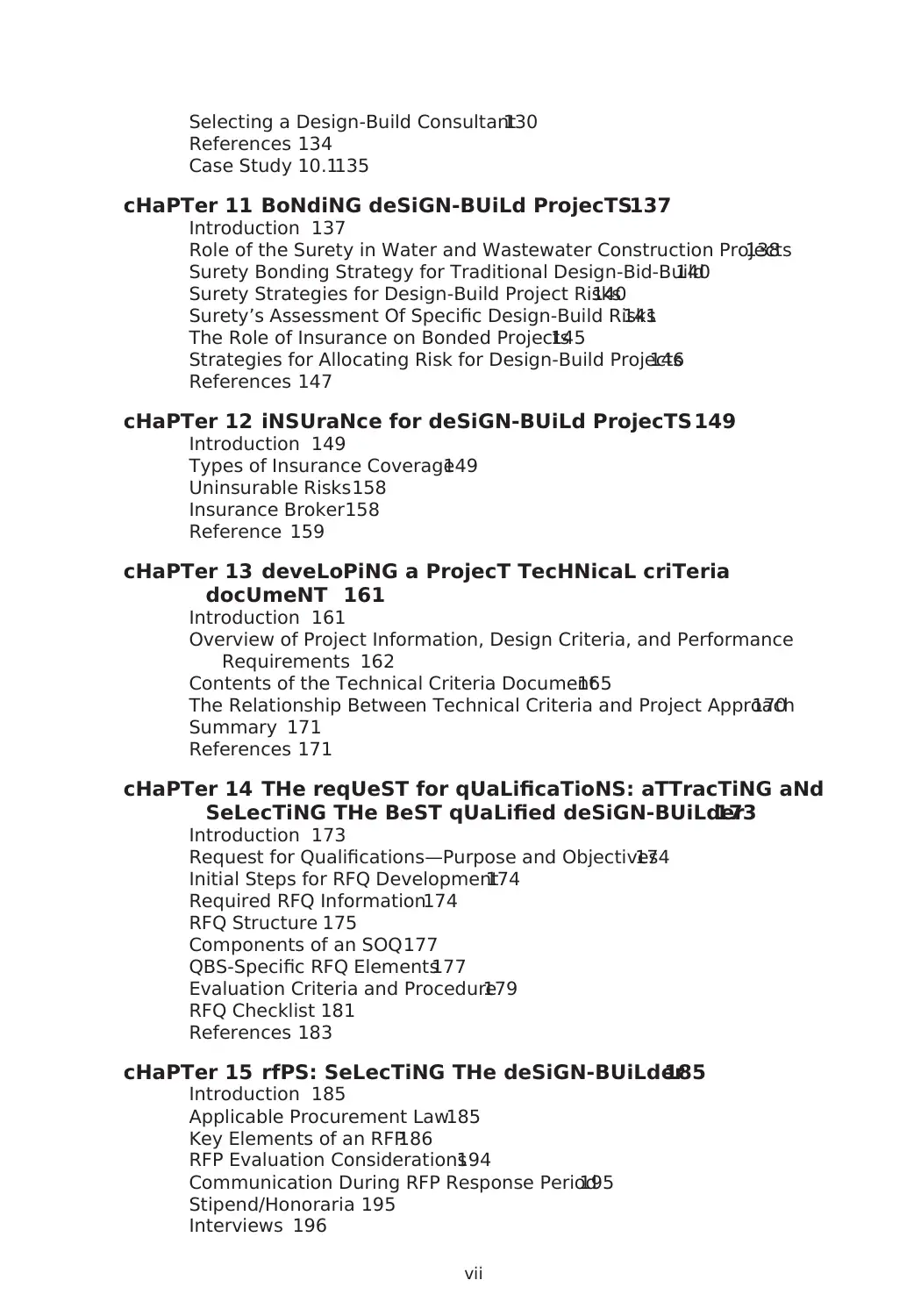
vii
Selecting a Design-Build Consultant130
References 134
Case Study 10.1135
cHaPTer 11 BoNdiNG deSiGN-BUiLd ProjecTS137
Introduction 137
Role of the Surety in Water and Wastewater Construction Projects138
Surety Bonding Strategy for Traditional Design-Bid-Build140
Surety Strategies for Design-Build Project Risks140
Surety’s Assessment Of Specific Design-Build Risks141
The Role of Insurance on Bonded Projects145
Strategies for Allocating Risk for Design-Build Projects146
References 147
cHaPTer 12 iNSUraNce for deSiGN-BUiLd ProjecTS 149
Introduction 149
Types of Insurance Coverage149
Uninsurable Risks 158
Insurance Broker158
Reference 159
cHaPTer 13 deveLoPiNG a ProjecT TecHNicaL criTeria
docUmeNT 161
Introduction 161
Overview of Project Information, Design Criteria, and Performance
Requirements 162
Contents of the Technical Criteria Document165
The Relationship Between Technical Criteria and Project Approach170
Summary 171
References 171
cHaPTer 14 THe reqUeST for qUaLificaTioNS: aTTracTiNG aNd
SeLecTiNG THe BeST qUaLified deSiGN-BUiLder173
Introduction 173
Request for Qualifications—Purpose and Objectives174
Initial Steps for RFQ Development174
Required RFQ Information174
RFQ Structure 175
Components of an SOQ 177
QBS-Specific RFQ Elements177
Evaluation Criteria and Procedure179
RFQ Checklist 181
References 183
cHaPTer 15 rfPS: SeLecTiNG THe deSiGN-BUiLder185
Introduction 185
Applicable Procurement Law185
Key Elements of an RFP186
RFP Evaluation Considerations194
Communication During RFP Response Period195
Stipend/Honoraria 195
Interviews 196
Selecting a Design-Build Consultant130
References 134
Case Study 10.1135
cHaPTer 11 BoNdiNG deSiGN-BUiLd ProjecTS137
Introduction 137
Role of the Surety in Water and Wastewater Construction Projects138
Surety Bonding Strategy for Traditional Design-Bid-Build140
Surety Strategies for Design-Build Project Risks140
Surety’s Assessment Of Specific Design-Build Risks141
The Role of Insurance on Bonded Projects145
Strategies for Allocating Risk for Design-Build Projects146
References 147
cHaPTer 12 iNSUraNce for deSiGN-BUiLd ProjecTS 149
Introduction 149
Types of Insurance Coverage149
Uninsurable Risks 158
Insurance Broker158
Reference 159
cHaPTer 13 deveLoPiNG a ProjecT TecHNicaL criTeria
docUmeNT 161
Introduction 161
Overview of Project Information, Design Criteria, and Performance
Requirements 162
Contents of the Technical Criteria Document165
The Relationship Between Technical Criteria and Project Approach170
Summary 171
References 171
cHaPTer 14 THe reqUeST for qUaLificaTioNS: aTTracTiNG aNd
SeLecTiNG THe BeST qUaLified deSiGN-BUiLder173
Introduction 173
Request for Qualifications—Purpose and Objectives174
Initial Steps for RFQ Development174
Required RFQ Information174
RFQ Structure 175
Components of an SOQ 177
QBS-Specific RFQ Elements177
Evaluation Criteria and Procedure179
RFQ Checklist 181
References 183
cHaPTer 15 rfPS: SeLecTiNG THe deSiGN-BUiLder185
Introduction 185
Applicable Procurement Law185
Key Elements of an RFP186
RFP Evaluation Considerations194
Communication During RFP Response Period195
Stipend/Honoraria 195
Interviews 196
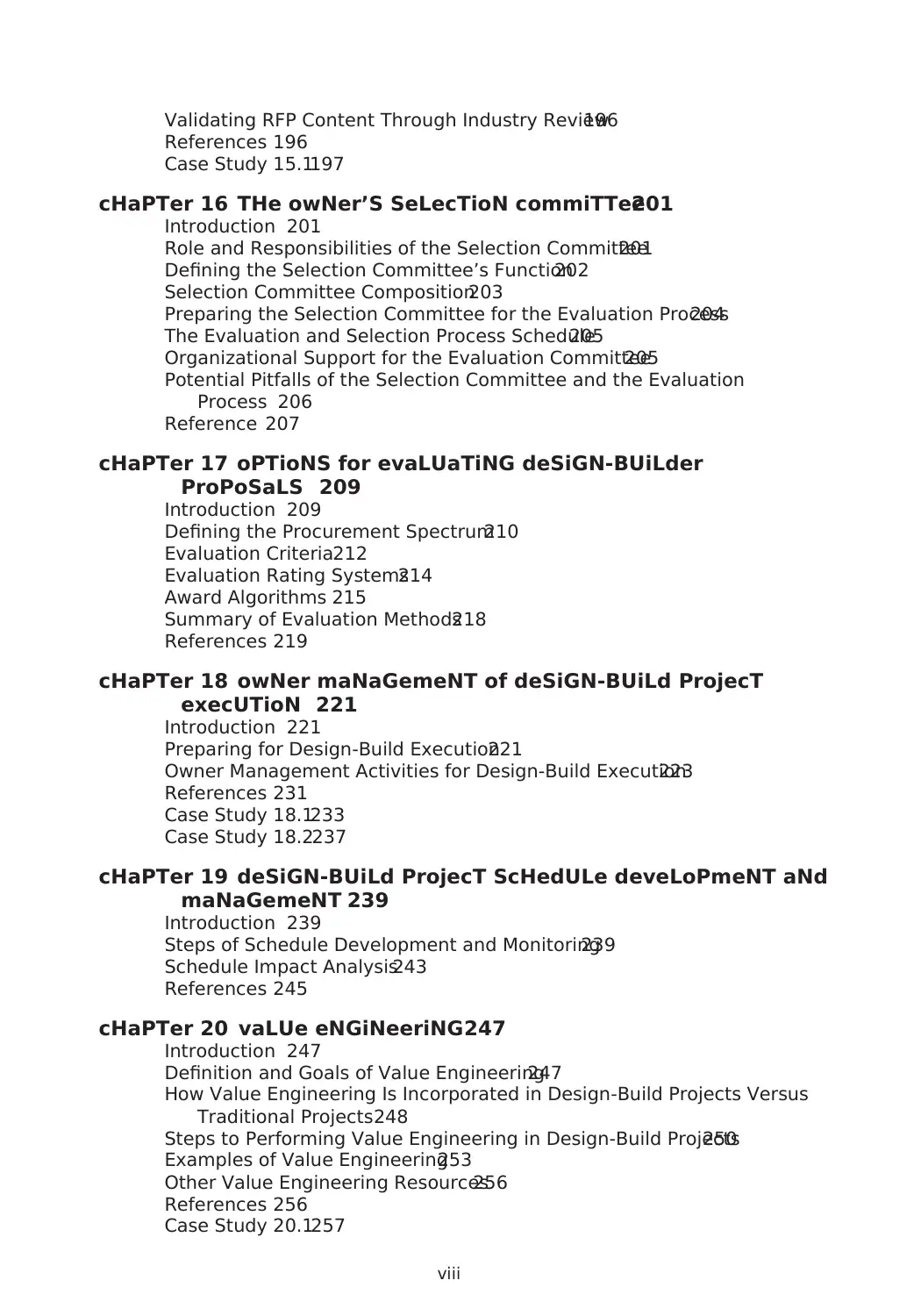
viii
Validating RFP Content Through Industry Review196
References 196
Case Study 15.1197
cHaPTer 16 THe owNer’S SeLecTioN commiTTee201
Introduction 201
Role and Responsibilities of the Selection Committee201
Defining the Selection Committee’s Function202
Selection Committee Composition203
Preparing the Selection Committee for the Evaluation Process204
The Evaluation and Selection Process Schedule205
Organizational Support for the Evaluation Committee205
Potential Pitfalls of the Selection Committee and the Evaluation
Process 206
Reference 207
cHaPTer 17 oPTioNS for evaLUaTiNG deSiGN-BUiLder
ProPoSaLS 209
Introduction 209
Defining the Procurement Spectrum210
Evaluation Criteria212
Evaluation Rating Systems214
Award Algorithms 215
Summary of Evaluation Methods218
References 219
cHaPTer 18 owNer maNaGemeNT of deSiGN-BUiLd ProjecT
execUTioN 221
Introduction 221
Preparing for Design-Build Execution221
Owner Management Activities for Design-Build Execution223
References 231
Case Study 18.1233
Case Study 18.2237
cHaPTer 19 deSiGN-BUiLd ProjecT ScHedULe deveLoPmeNT aNd
maNaGemeNT 239
Introduction 239
Steps of Schedule Development and Monitoring239
Schedule Impact Analysis243
References 245
cHaPTer 20 vaLUe eNGiNeeriNG 247
Introduction 247
Definition and Goals of Value Engineering247
How Value Engineering Is Incorporated in Design-Build Projects Versus
Traditional Projects248
Steps to Performing Value Engineering in Design-Build Projects250
Examples of Value Engineering253
Other Value Engineering Resources256
References 256
Case Study 20.1257
Validating RFP Content Through Industry Review196
References 196
Case Study 15.1197
cHaPTer 16 THe owNer’S SeLecTioN commiTTee201
Introduction 201
Role and Responsibilities of the Selection Committee201
Defining the Selection Committee’s Function202
Selection Committee Composition203
Preparing the Selection Committee for the Evaluation Process204
The Evaluation and Selection Process Schedule205
Organizational Support for the Evaluation Committee205
Potential Pitfalls of the Selection Committee and the Evaluation
Process 206
Reference 207
cHaPTer 17 oPTioNS for evaLUaTiNG deSiGN-BUiLder
ProPoSaLS 209
Introduction 209
Defining the Procurement Spectrum210
Evaluation Criteria212
Evaluation Rating Systems214
Award Algorithms 215
Summary of Evaluation Methods218
References 219
cHaPTer 18 owNer maNaGemeNT of deSiGN-BUiLd ProjecT
execUTioN 221
Introduction 221
Preparing for Design-Build Execution221
Owner Management Activities for Design-Build Execution223
References 231
Case Study 18.1233
Case Study 18.2237
cHaPTer 19 deSiGN-BUiLd ProjecT ScHedULe deveLoPmeNT aNd
maNaGemeNT 239
Introduction 239
Steps of Schedule Development and Monitoring239
Schedule Impact Analysis243
References 245
cHaPTer 20 vaLUe eNGiNeeriNG 247
Introduction 247
Definition and Goals of Value Engineering247
How Value Engineering Is Incorporated in Design-Build Projects Versus
Traditional Projects248
Steps to Performing Value Engineering in Design-Build Projects250
Examples of Value Engineering253
Other Value Engineering Resources256
References 256
Case Study 20.1257
⊘ This is a preview!⊘
Do you want full access?
Subscribe today to unlock all pages.

Trusted by 1+ million students worldwide
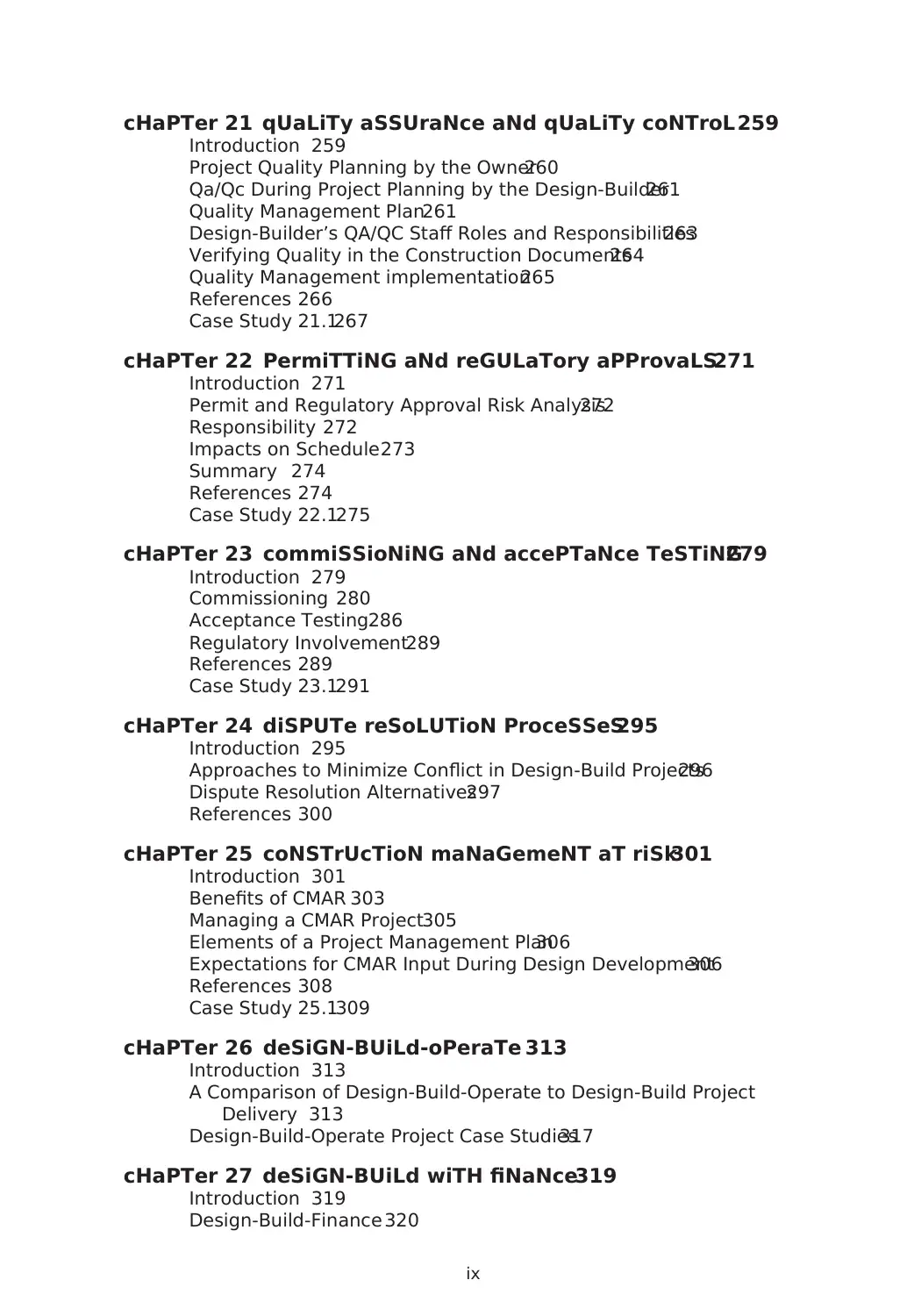
ix
cHaPTer 21 qUaLiTy aSSUraNce aNd qUaLiTy coNTroL 259
Introduction 259
Project Quality Planning by the Owner260
Qa/Qc During Project Planning by the Design-Builder261
Quality Management Plan261
Design-Builder’s QA/QC Staff Roles and Responsibilities263
Verifying Quality in the Construction Documents264
Quality Management implementation265
References 266
Case Study 21.1267
cHaPTer 22 PermiTTiNG aNd reGULaTory aPProvaLS271
Introduction 271
Permit and Regulatory Approval Risk Analysis272
Responsibility 272
Impacts on Schedule 273
Summary 274
References 274
Case Study 22.1275
cHaPTer 23 commiSSioNiNG aNd accePTaNce TeSTiNG279
Introduction 279
Commissioning 280
Acceptance Testing286
Regulatory Involvement289
References 289
Case Study 23.1291
cHaPTer 24 diSPUTe reSoLUTioN ProceSSeS295
Introduction 295
Approaches to Minimize Conflict in Design-Build Projects296
Dispute Resolution Alternatives297
References 300
cHaPTer 25 coNSTrUcTioN maNaGemeNT aT riSk301
Introduction 301
Benefits of CMAR 303
Managing a CMAR Project305
Elements of a Project Management Plan306
Expectations for CMAR Input During Design Development306
References 308
Case Study 25.1309
cHaPTer 26 deSiGN-BUiLd-oPeraTe 313
Introduction 313
A Comparison of Design-Build-Operate to Design-Build Project
Delivery 313
Design-Build-Operate Project Case Studies317
cHaPTer 27 deSiGN-BUiLd wiTH fiNaNce319
Introduction 319
Design-Build-Finance 320
cHaPTer 21 qUaLiTy aSSUraNce aNd qUaLiTy coNTroL 259
Introduction 259
Project Quality Planning by the Owner260
Qa/Qc During Project Planning by the Design-Builder261
Quality Management Plan261
Design-Builder’s QA/QC Staff Roles and Responsibilities263
Verifying Quality in the Construction Documents264
Quality Management implementation265
References 266
Case Study 21.1267
cHaPTer 22 PermiTTiNG aNd reGULaTory aPProvaLS271
Introduction 271
Permit and Regulatory Approval Risk Analysis272
Responsibility 272
Impacts on Schedule 273
Summary 274
References 274
Case Study 22.1275
cHaPTer 23 commiSSioNiNG aNd accePTaNce TeSTiNG279
Introduction 279
Commissioning 280
Acceptance Testing286
Regulatory Involvement289
References 289
Case Study 23.1291
cHaPTer 24 diSPUTe reSoLUTioN ProceSSeS295
Introduction 295
Approaches to Minimize Conflict in Design-Build Projects296
Dispute Resolution Alternatives297
References 300
cHaPTer 25 coNSTrUcTioN maNaGemeNT aT riSk301
Introduction 301
Benefits of CMAR 303
Managing a CMAR Project305
Elements of a Project Management Plan306
Expectations for CMAR Input During Design Development306
References 308
Case Study 25.1309
cHaPTer 26 deSiGN-BUiLd-oPeraTe 313
Introduction 313
A Comparison of Design-Build-Operate to Design-Build Project
Delivery 313
Design-Build-Operate Project Case Studies317
cHaPTer 27 deSiGN-BUiLd wiTH fiNaNce319
Introduction 319
Design-Build-Finance 320
Paraphrase This Document
Need a fresh take? Get an instant paraphrase of this document with our AI Paraphraser

x
Design-Build-Operate-Finance (DBOF)320
Case Study 27.1323
Case Study 27.2325
cHaPTer 28 aLLiaNce coNTracTiNG 327
Introduction 327
Benefits and Challenges of Alliance Contracting331
Example Projects in Australia331
The Potential for Alliance Contracting in the United States333
References 334
cHaPTer 29 ToP TeN STraTeGieS for owNerS To acHieve
a SUcceSSfUL deSiGN-BUiLd ProjecT335
Introduction 335
Provide Organizational Leadership and Support336
Proactively Educate, Inform, and Communicate With All Stakeholders336
Select the Right Projects336
Clearly Define the Project337
Define and Commit to Project Objectives337
Establish a Fair, Clearly Defined, Efficient, and Transparent Procurement
Process 338
Attract the Best Design-Build Firms to Compete for the Project339
Select the Right Design-Build Team339
Make Cultural Adjustments to Establish a True Partnership340
Develop Design-Build Project Execution Processes and Procedures That
Promote and Leverage Collaboration and Partnership340
cHaPTer 30 iS deSiGN-BUiLd riGHT for yoU?343
Introduction 343
Key Points to Consider for Design-Build Project Delivery344
Common Owner Fears 347
Benefits of Design-Build Project Delivery Approach348
aPPeNdix a: aBBreviaTioNS351
iNdex 357
Design-Build-Operate-Finance (DBOF)320
Case Study 27.1323
Case Study 27.2325
cHaPTer 28 aLLiaNce coNTracTiNG 327
Introduction 327
Benefits and Challenges of Alliance Contracting331
Example Projects in Australia331
The Potential for Alliance Contracting in the United States333
References 334
cHaPTer 29 ToP TeN STraTeGieS for owNerS To acHieve
a SUcceSSfUL deSiGN-BUiLd ProjecT335
Introduction 335
Provide Organizational Leadership and Support336
Proactively Educate, Inform, and Communicate With All Stakeholders336
Select the Right Projects336
Clearly Define the Project337
Define and Commit to Project Objectives337
Establish a Fair, Clearly Defined, Efficient, and Transparent Procurement
Process 338
Attract the Best Design-Build Firms to Compete for the Project339
Select the Right Design-Build Team339
Make Cultural Adjustments to Establish a True Partnership340
Develop Design-Build Project Execution Processes and Procedures That
Promote and Leverage Collaboration and Partnership340
cHaPTer 30 iS deSiGN-BUiLd riGHT for yoU?343
Introduction 343
Key Points to Consider for Design-Build Project Delivery344
Common Owner Fears 347
Benefits of Design-Build Project Delivery Approach348
aPPeNdix a: aBBreviaTioNS351
iNdex 357
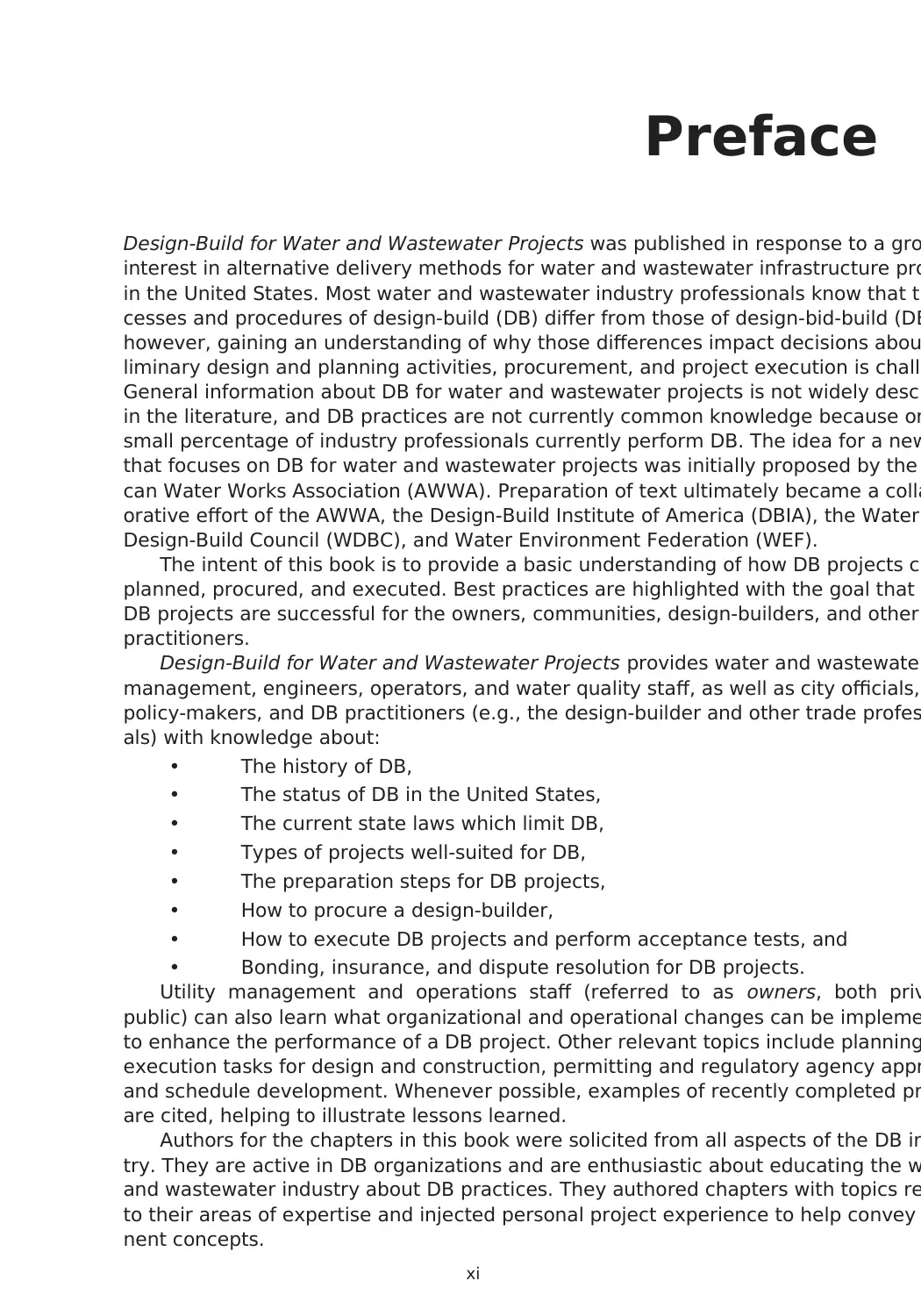
xi
Preface
Design-Build for Water and Wastewater Projects was published in response to a gro
interest in alternative delivery methods for water and wastewater infrastructure pro
in the United States. Most water and wastewater industry professionals know that th
cesses and procedures of design-build (DB) differ from those of design-bid-build (DB
however, gaining an understanding of why those differences impact decisions abou
liminary design and planning activities, procurement, and project execution is challe
General information about DB for water and wastewater projects is not widely descr
in the literature, and DB practices are not currently common knowledge because on
small percentage of industry professionals currently perform DB. The idea for a new
that focuses on DB for water and wastewater projects was initially proposed by the
can Water Works Association (AWWA). Preparation of text ultimately became a colla
orative effort of the AWWA, the Design-Build Institute of America (DBIA), the Water
Design-Build Council (WDBC), and Water Environment Federation (WEF).
The intent of this book is to provide a basic understanding of how DB projects ca
planned, procured, and executed. Best practices are highlighted with the goal that f
DB projects are successful for the owners, communities, design-builders, and other
practitioners.
Design-Build for Water and Wastewater Projects provides water and wastewater
management, engineers, operators, and water quality staff, as well as city officials,
policy-makers, and DB practitioners (e.g., the design-builder and other trade profes
als) with knowledge about:
• The history of DB,
• The status of DB in the United States,
• The current state laws which limit DB,
• Types of projects well-suited for DB,
• The preparation steps for DB projects,
• How to procure a design-builder,
• How to execute DB projects and perform acceptance tests, and
• Bonding, insurance, and dispute resolution for DB projects.
Utility management and operations staff (referred to as owners, both priv
public) can also learn what organizational and operational changes can be impleme
to enhance the performance of a DB project. Other relevant topics include planning
execution tasks for design and construction, permitting and regulatory agency appr
and schedule development. Whenever possible, examples of recently completed pr
are cited, helping to illustrate lessons learned.
Authors for the chapters in this book were solicited from all aspects of the DB in
try. They are active in DB organizations and are enthusiastic about educating the w
and wastewater industry about DB practices. They authored chapters with topics re
to their areas of expertise and injected personal project experience to help convey
nent concepts.
Preface
Design-Build for Water and Wastewater Projects was published in response to a gro
interest in alternative delivery methods for water and wastewater infrastructure pro
in the United States. Most water and wastewater industry professionals know that th
cesses and procedures of design-build (DB) differ from those of design-bid-build (DB
however, gaining an understanding of why those differences impact decisions abou
liminary design and planning activities, procurement, and project execution is challe
General information about DB for water and wastewater projects is not widely descr
in the literature, and DB practices are not currently common knowledge because on
small percentage of industry professionals currently perform DB. The idea for a new
that focuses on DB for water and wastewater projects was initially proposed by the
can Water Works Association (AWWA). Preparation of text ultimately became a colla
orative effort of the AWWA, the Design-Build Institute of America (DBIA), the Water
Design-Build Council (WDBC), and Water Environment Federation (WEF).
The intent of this book is to provide a basic understanding of how DB projects ca
planned, procured, and executed. Best practices are highlighted with the goal that f
DB projects are successful for the owners, communities, design-builders, and other
practitioners.
Design-Build for Water and Wastewater Projects provides water and wastewater
management, engineers, operators, and water quality staff, as well as city officials,
policy-makers, and DB practitioners (e.g., the design-builder and other trade profes
als) with knowledge about:
• The history of DB,
• The status of DB in the United States,
• The current state laws which limit DB,
• Types of projects well-suited for DB,
• The preparation steps for DB projects,
• How to procure a design-builder,
• How to execute DB projects and perform acceptance tests, and
• Bonding, insurance, and dispute resolution for DB projects.
Utility management and operations staff (referred to as owners, both priv
public) can also learn what organizational and operational changes can be impleme
to enhance the performance of a DB project. Other relevant topics include planning
execution tasks for design and construction, permitting and regulatory agency appr
and schedule development. Whenever possible, examples of recently completed pr
are cited, helping to illustrate lessons learned.
Authors for the chapters in this book were solicited from all aspects of the DB in
try. They are active in DB organizations and are enthusiastic about educating the w
and wastewater industry about DB practices. They authored chapters with topics re
to their areas of expertise and injected personal project experience to help convey
nent concepts.
⊘ This is a preview!⊘
Do you want full access?
Subscribe today to unlock all pages.

Trusted by 1+ million students worldwide

xii
The development of Design-Build for Water and Wastewater Projects greatly bene
from the assistance of several people. Sarah Chittenden of the WDBC provided industr
information and a link to several authors. Chuck Williams and Patrick Gallagher were
willing advisors for technical and editorial decisions. The WDBC provided guidance on
topics for the outline. Lisa Washington, John Young, and Jack Gallagher, leaders within
DBIA, provided assistance and guidance throughout the book effort. Marlay B. P
of Gannett Fleming Inc. and past president of the American Water Works Association
helped solicit the case studies. Black & Veatch Corporation supported the editorial act
ties. Beth Edie and Julie Farmer, both at Black & Veatch Corporation, worked diligently
on formatting of text and figures.
Holly Shorney-Darby, PhD, PE, Editor
Senior Process Engineer, Black & Veatch Corporation
The development of Design-Build for Water and Wastewater Projects greatly bene
from the assistance of several people. Sarah Chittenden of the WDBC provided industr
information and a link to several authors. Chuck Williams and Patrick Gallagher were
willing advisors for technical and editorial decisions. The WDBC provided guidance on
topics for the outline. Lisa Washington, John Young, and Jack Gallagher, leaders within
DBIA, provided assistance and guidance throughout the book effort. Marlay B. P
of Gannett Fleming Inc. and past president of the American Water Works Association
helped solicit the case studies. Black & Veatch Corporation supported the editorial act
ties. Beth Edie and Julie Farmer, both at Black & Veatch Corporation, worked diligently
on formatting of text and figures.
Holly Shorney-Darby, PhD, PE, Editor
Senior Process Engineer, Black & Veatch Corporation
1 out of 10
Your All-in-One AI-Powered Toolkit for Academic Success.
+13062052269
info@desklib.com
Available 24*7 on WhatsApp / Email
![[object Object]](/_next/static/media/star-bottom.7253800d.svg)
Unlock your academic potential
Copyright © 2020–2025 A2Z Services. All Rights Reserved. Developed and managed by ZUCOL.

